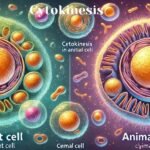When an inquirer asks about the significance of timing, the answer likely involves: organizing tasks. Everyone has many daily tasks that are required to be performed at specific times. As well, it’s self-evident for everyone to have a share of peace and tranquility with others. Likewise, our bodies from within, have multiple tasks that they perform daily. These tasks are known as the “circadian rhythm”, as their rate increases at times and decreases at others. The heart rate, temperature and cortisol level rise during the day, and abate at night. Melatonin rises at night and also decreases morning.
So, how does your internal circadian rhythm synchronize with your external timing?
Every cell in our bodies has its biological clock. Which is called the “Peripheral Circadian Clock”. One of its missions is to synchronize and match our external time. How does that come about? There is another type of the bio-clocks within our brains known as, “SCN Supra Chiasmatic Nuclei” which consists of a group of nerve cells that are located above the optic nerves. Therefore, the work of this nuclei is related to fluctuations in light between night and day.
When the sun’s light enters through your retina, is directly transformed into electrical signals that pass through the Retinal Hypothalamic tract to be transformed again into chemical signals (eg. Serotonin) in the central clock region of your brain. Which causes synchronization between the internal bio-clock and the external time, making you feel awake. As well, when darkness falls, the central clock (SCN) stimulates sleep by signaling the release of the melatonin hormone.
In the view of the foregoing explanation, this “Nuclei-SCN” adjusts all the peripheral bio-clocks within every cell in our bodies, to its same time. So, its the central biological clock we have.
Note: this nuclei -SCN is characterized by being independent. As it able to regulate itself even if the person is isolated from light for long periods. As well, it has the ability to modify itself based on some surrounding factors such as temperature and muscle activity.
Bio-clock’s molecular level

Here’s a summary of the work that won the 2017 Nobel Prize in Medicine, which shows how a 24-hour rhythm can be generated at the cellular level that is synchronized and interconnected with external timing:
All cells in our bodies are in a state of a physiological oscillation 24 hours a day. During the night, specific types of proteins accumulate in the cell cytoplasm, which are degraded again in the morning. Thus, its levels fluctuate during the day.
For further explaining, in the nucleus of every cell we have, there are two types of biological clock’s proteins:
- Clock
- BMAL-1
Next to these two proteins is the cell’s own DNA. Each of them interacts with a specific part of the DNA which called (E-BOX) region. This reaction results in the transcription of several genes, including a gene called “period” and another one called “cryptochrome”. By their nature, they will be translated (decoded) in the cell’s cytoplasm via ribosomes into proteins. Once the “period protein” accumulates in the cytoplasm of the cell and reaches its maximum, it binds to the “Cryptochrome protein” and moves back to the nucleus to inhibit both the “clock protein and BMAL-1”. As a way to abate the rate of transcription/translation of the “period protein,” which reached its maximum in the cytoplasm.
Once the period protein degrades and its levels become low, both (BMAL1 and CLOCK) are reactivated, repeating the interaction with the (E-BOX) region of the DNA, and reactivating the process of transcription/translation of more of the period gene/protein so that its level rises again in the cytoplasm. And this cycle takes about twenty-four hours.
In light of this, we can posit that: Circadian clock proteins are in a state of repeated oscillation inside our cells during day and night. But your external day always contains twenty-four hours. While your internal biological clock “remember it as the process of protein accumulation and degradation,” therefore does not have to be exactly 24 hours long. Hence, at the molecular level, the mechanism of the daily biological clock has been described as a translation/transcription oscillator (TTO) cycle. Which means, the process of gene transcription, translation oscillates between inhibition and activation, during day and night fluctuations.
These proteins, which oscillate daily, control the regulation of many hormones and enzymes that have an important role in many vital functions within our bodies, as represented in cellular metabolism. So, the activity of these hormones/enzymes fluctuates over day and night too. Thus, there is synchronization and interconnection between your body’s daily tasks and its external timing.
Functions of biological clock proteins

Based on a research study published on PubMed under the title “Time-Restricted Nutrition and Reorganization of Circadian Rhythms,” impaired glucose metabolism due to decreased insulin secretion or cell resistance has been linked to a defect in circadian clock proteins. Thus, if there is any defect in this oscillatory process of the accumulation and degradation of (Clock, BMAL-1 Proteins) inside the cell. Leads to a defect in the important vital processes, through the activation/inhibition of a specific enzyme or hormone, such as insulin, which ultimately causes to impaired glucose metabolism. Which appears to us in the form of a disease such as diabetes.
Therefore, a slight defect in the genes/proteins of the circadian clock inside our cells leads to, disruption of many vital functions within the human body, resulting in multiple diseases, including chronic diseases such as depression, cancer, and heart diseases too. If the heart cells have any defect in their bio-clock protein content, it will affect on electrical activity.
In keeping with the foregoing explanation, the occurrence of many vital processes within the cell depends on the extent of the activity of circadian clock proteins (CLOCK, BMAL1). Therefore, there are enzymes and vital functions whose rate rises during the day when these proteins are active, while others decline at night when they are inhibited, and vice versa.
So that, some doctors may take advantage of writing medications at specific times than others because those times may enhance the effectiveness of the medication on the target based on the daily circadian rhythm. So, it is important to take good care of our biological clock rhythm and not disturb it. If we do not do so, the consequences will be dire.
Recommended Readings:
How Life Science is Evolving in the Modern Age
Physical Science Exploring the Fundamentals of Our Physical World
References
1. Sunderram J, Sofou S, Kamisoglu K, Karantza V, Androulakis IP. Time-restricted feeding and the realignment of biological rhythms: translational opportunities and challenges. J Transl Med. 2014 Mar 28;12:79. doi: 10.1186/1479-5876-12-79. PMID: 24674294; PMCID: PMC3973614. DOI: 10.1186/1479-5876-12-79
2. Am J Physiol Regul Integr Comp Physiol. Mechanism of the Circadian Clock in Physiology.2013 Jun 15; 304(12): R1053–R1064. Published online 2013 Apr 10. doi: 10.1152/ajpregu.00066.2013
3. Mohawk JA, Green CB, Takahashi JS. Central and peripheral circadian clocks in mammals. Annu Rev Neurosci. 2012;35:445-62. doi: 10.1146/annurev-neuro-060909-153128. Epub 2012 Apr 5. PMID: 22483041; PMCID: PMC3710582 https://www.ncbi.nlm.nih.gov/pmc/articles/PMC3710582/
4. Wenqian ZH., Yuan X., Ranyang T. Emerging Insight Into the Role of Circadian Clock Gene BMAL1 in Cellular Senescence. June 2022.
DOI:10.3389/fendo.2022.915139
5. Ma MA, Morrison EH. Neuroanatomy, Nucleus Suprachiasmatic. [Updated 2023 Jul 24]. In: StatPearls [Internet]. Treasure Island (FL): StatPearls Publishing; 2023 Jan-. Available from: https://www.ncbi.nlm.nih.gov/books/NBK546664/M















